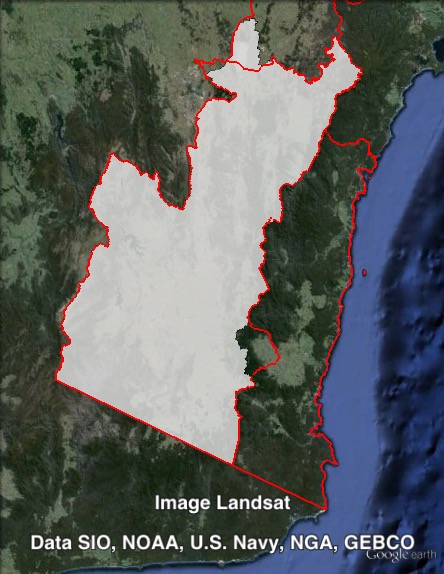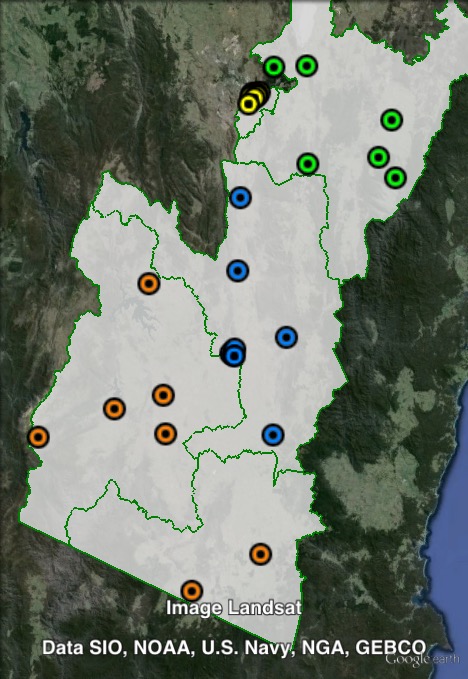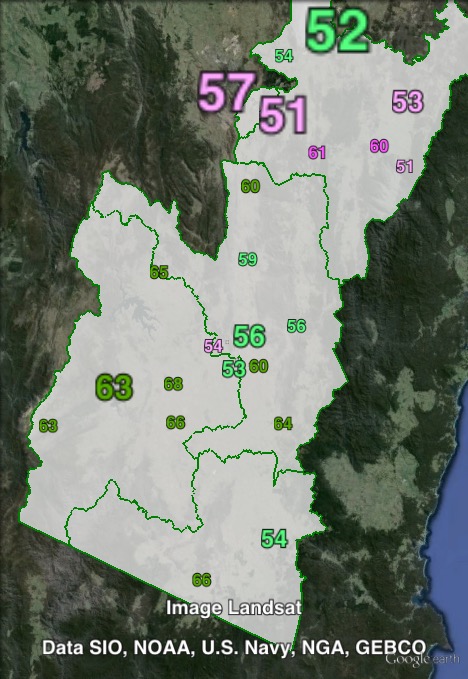NAT 2.0%
Incumbent MP
John Barilaro, since 2011.
Geography
Southeastern NSW. Monaro covers inland parts of southeastern NSW to the south and east of the ACT. The seat includes Queanbeyan, Cooma and the Snowy Mountains. It covers all of Queanbeyan, Bombala, Cooma-Monaro, Palerang and Snowy River local government areas.

Redistribution
Minor changes were made to Monaro’s boundaries, aligning the seat’s boundaries with local government boundaries. A small part of Bega Valley council area, around Bemboka, was transferred from Monaro to Bega. Those parts of Palerang council area previously contained in Goulburn were transferred to Monaro, while the small part of Yass Valley council area in Monaro was moved into Goulburn.
History
The seat of Monaro was first creating in 1858, and apart from three terms in the 1920s, Monaro has existed as an electoral district ever since.
The seat was abolished in 1920 when proportional representation was introduced, and Monaro was included in the three-member Goulburn district.
When Monaro was introduced in 1927 it was won by the Country Party’s William Hedges. Hedges held the seat until 1941, when he lost to the ALP’s John Seiffert by 181 votes.
Prior to the 1950 election, Seiffert was disendorsed by the ALP after he voted against the party’s candidate for a Legislative Council vacancy. He was re-elected in Monaro without an official Labor opponent, and was eventually readmitted to the party. He continued to serve in Monaro until his retirement in 1965.
In 1965, Seiffert retired, and his son ran as the Labor candidate, losing to the Liberal candidate Steve Mauger in a three-cornered contest, with Country Party preferences electing the Liberal by only 268 votes. Mauger held the seat until his retirement in 1976, serving as a junior minister for the final year of his term.
In 1976, another three-cornered contest saw Labor candidate John Akister win despite the combined Country Party and Liberal Party vote adding up to a majority. Akister held the seat until 1988, serving as a minister from 1984 to 1988. In 1988, he lost his seat in the anti-Labor landslide to the National Party’s Peter Cochran.
Cochran held the seat until 1999, when he retired. He was succeeded by fellow National Peter Webb. Webb held the seat for one term, and lost to the ALP’s Steve Whan in 2003.
Whan was re-elected in 2007, and served as a minister in the Labor government from 2009 to 2011.
In 2011, Whan lost Monaro to Nationals candidate John Barilaro with an 8.4% swing. Whan was appointed to fill a vacancy in the Legislative Council in June 2011.
Candidates
Former Monaro MP Steve Whan is resigning from the Legislative Council to re-contest his seat.
- Steve Whan (Labor)
- Peter Marshall (Greens)
- John Barilaro (Nationals)
- Leslie Dinham (No Land Tax)
- Joy Horton (Christian Democratic Party)
Assessment
Monaro has been a long-standing marginal seat. While Labor lost Monaro in 2011, the swing was not as severe as in urban areas. So while you would expect a swing back to Labor, it may not be as large as expected elsewhere. Having said that, it seems unlikely that the Nationals will be able to defend a 2% margin after the last election, particularly with the former MP returning to contest the seat.
2011 election result
| Candidate | Party | Votes | % | Swing | Redist |
| John Barilaro | Nationals | 21,134 | 47.1 | +7.8 | 47.0 |
| Steve Whan | Labor | 18,381 | 41.0 | -6.9 | 41.2 |
| Paul Cockram | Greens | 3,524 | 7.9 | -2.1 | 7.7 |
| Kingsley Warburton | Independent | 1,218 | 2.7 | +2.7 | 2.7 |
| Deanne Graf | Christian Democrats | 618 | 1.4 | +1.4 | 1.4 |
2011 two-party-preferred result
| Candidate | Party | Votes | % | Swing | Redist |
| John Barilaro | Nationals | 21,918 | 52.1 | +8.4 | 52.0 |
| Steve Whan | Labor | 20,178 | 47.9 | -8.4 | 48.0 |

Booth breakdown
Booths in Monaro have been split into four areas. Polling places in the Queanbeyan, Palerang and Cooma-Monaro council areas have been grouped together. Polling places in the Bombala and Snowy River council areas have been grouped as “South”. A majority of the seat’s population lives in the City of Queanbeyan.
The Nationals won a 62% majority of the two-party-preferred vote in the south, and a 56.5% majority in Cooma-Monaro. Labor won 50.5% in Palerang, and 52.2% in Queanbeyan. The Nationals also won a solid 54.4% majority amongst the special votes, which were decisive in giving them the win.
The Greens vote ranged from 5.4% in the south to 13.3% in Palerang.
| Voter group | NAT 2PP % | GRN % | Total votes | % of votes |
| Queanbeyan | 47.8 | 6.8 | 17,894 | 41.2 |
| Palerang | 49.5 | 13.3 | 4,952 | 11.4 |
| South | 61.9 | 5.4 | 3,786 | 8.7 |
| Cooma-Monaro | 56.5 | 5.8 | 3,747 | 8.6 |
| Other votes | 54.4 | 7.9 | 13,076 | 30.1 |



My prediction: Steve Whan should easily win this back for Labor. When Whan retires though, this will be one to watch.
The below trend swing in 2011 is interesting. Does it represent a subtle pro-Labor realignment? Is it indicative Whan’s popularity? Perhaps the Coalition would be better served by a Liberal candidate here.
David Walsh, think the low swing has to do with Whan’s popularity, which is more important in a regional electorate. It’s also quite a polarised electorate IMO, the rural areas can’t get more National than what they currently are, whereas Queanbeyan is a Canberra suburb and therefore probably didn’t suffer from the same factors that saw the big swings in the rest of New South Wales.
Lots of the Queanbeyan residents work in Canberra and access Canberra services – decisions made by the ACT govt are important to them Sydney is far away with typically the regional office for state services in Wollongong or Goulburn. The demographics probably are working in the ALPs favour here.
Considering that a majority of the electorate lives in Queanbeyan (which is less of a country town and more the outer suburbs of Canberra) it is surprising that the Liberal Party doesn’t run here.
Is there some agreement on not contesting seats held by the Coalition partner? Certainly Liberals have been running at the Federal level in Eden-Monaro which overlaps with Monaro
Yes, part of the Coalition agreement. Last time there was a 3-cornered contest was in 1999. The primary vote was 8,477 NAT (first spot on ballot paper) to 7,521 LIB (4th spot on ballot paper out of 8 candidates). Demographic change may well reverse that result after 15 years.
Steve Whan did remarkably well to go as close as he did to holding on here in 2011, and it would be very surprising if he didn’t win the seat back, even though, as noted above, he can’t rely on a 10% statewide swing to carry him over the line as some candidates in Sydney can. He has used his place in the Leg Council to keep up his local profile and highlight regional issues. Monaro is not a natural Nats seat and the Lib-Nat deal that gave it to the Nats doesn’t help their chances of holding it, especially since Barilaro is obviously long-term backbench material. As noted, Queanbeyan is really a Canberra suburb, with a high level of public servants, and shares the animosity of most Canberra voters to the Abbott government. Palerang Shire is also full of Canberra people and retired public servants. Some of that animosity will spill over into their state voting. Most of these factors will also apply when Mike Kelly runs for Eden-Monaro again next year.
Well, John Barilaro is Minister for Small Business and Regional Tourism, so he’s not on the backbench at the moment. I note that he is from Queanbeyan, and was a Councillor there, so maybe it will help his cause to have a local vote in the largest population centre? That said, I think he will face a very difficult task with only a 2% margin.
The bookies think this will be close, offering $1.70 for Whan, which I think is quitr generous. The anti-Abbott factor here will be larger than elsewhere because of the proximity to job cuts in the ACT. I’d tip Whan with a7% swing.
This will be a tight seat. John Barilaro is developing his profile but the fact Whan is coming back makes this a flip of the coin. But Barilaro has to compete with the Anti-Abbott sentiment from Canberra. I would put Whan as favourite but this will be one to watch
This will be a close contest with 2 excellent candidates from Queanbeyan.
I thought this was a surprising result. I thought Whan would romp it home, even with the sitting member factor.
I thought Whan would win but remember how Nats consolidated in this seat after winning in 1988 with a strong MP.
It is very interesting – next door in Bega there was a substantial anti-coalition swing – over 10% from memory. The Nationals candidate says he is only going to serve this term and move on.
Obviously I and many others seriously under-estimated Barilaro’s success in entrenching himself in this seat.
I live roughly in the middle of the seat.
Have a feeling that labor may have been a bit complacent about a seat that is sensitive to being ‘taken for granted’.
For example a possible factor in may have been the proposal to instal a gold processing i.e cyanide using plant at Majors creek -these days a much more populous place than it was 5 (or more) years ago. There was a big meeting with the candidates- the greens stated their opposition, and Barilaro spoke convincingly of fighting it tooth and nail, Whan in comparison, was for some reason, a ‘no show’.
I think the more interesting question is why the anti-Abbott sentiment among public servants living in middle-income Queanbeyan suburbs like Jerrabomberra and Karabar did not translate into votes for Labor. This must be a bit of a worry for Mike Kelly, because he won’t win Eden-Monaro back unless he gets big swings in those booths.
At the last federal election Kelly , from memory, got about 55% of the votes in Queanbeyan, but still lost, such was the swing against him in the rest of the electorate.